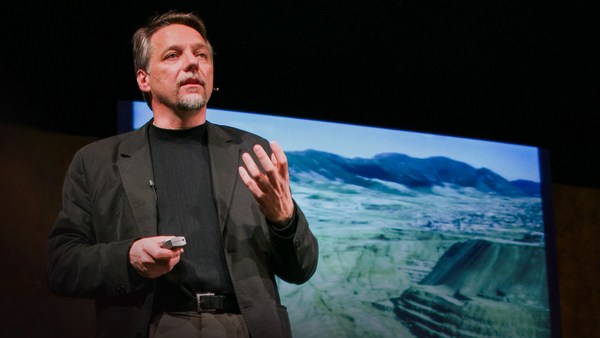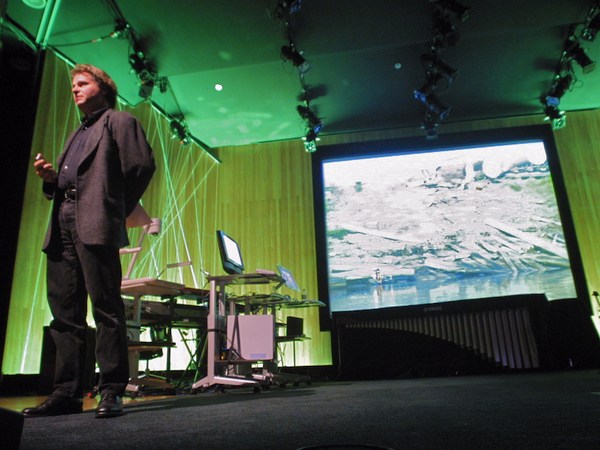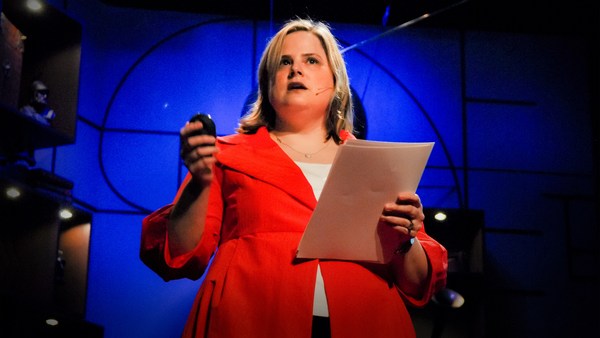My work is about the behaviors that we all engage in unconsciously, on a collective level. And what I mean by that, it's the behaviors that we're in denial about, and the ones that operate below the surface of our daily awareness. And as individuals, we all do these things, all the time, everyday. It's like when you're mean to your wife because you're mad at somebody else. Or when you drink a little too much at a party, just out of anxiety. Or when you overeat because your feelings are hurt, or whatever. And when we do these kind of things, when 300 million people do unconscious behaviors, then it can add up to a catastrophic consequence that nobody wants, and no one intended. And that's what I look at with my photographic work.
This is an image I just recently completed, that is -- when you stand back at a distance, it looks like some kind of neo-Gothic, cartoon image of a factory spewing out pollution. And as you get a little bit closer, it starts looking like lots of pipes, like maybe a chemical plant, or a refinery, or maybe a hellish freeway interchange. And as you get all the way up close, you realize that it's actually made of lots and lots of plastic cups. And in fact, this is one million plastic cups, which is the number of plastic cups that are used on airline flights in the United States every six hours. We use four million cups a day on airline flights, and virtually none of them are reused or recycled. They just don't do that in that industry.
Now, that number is dwarfed by the number of paper cups we use every day, and that is 40 million cups a day for hot beverages, most of which is coffee. I couldn't fit 40 million cups on a canvas, but I was able to put 410,000. That's what 410,000 cups looks like. That's 15 minutes of our cup consumption. And if you could actually stack up that many cups in real life, that's the size it would be. And there's an hour's worth of our cups. And there's a day's worth of our cups. You can still see the little people way down there. That's as high as a 42-story building, and I put the Statue of Liberty in there as a scale reference.
Speaking of justice, there's another phenomenon going on in our culture that I find deeply troubling, and that is that America, right now, has the largest percentage of its population in prison of any country on Earth. One out of four people, one out of four humans in prison are Americans, imprisoned in our country. And I wanted to show the number. The number is 2.3 million Americans were incarcerated in 2005. And that's gone up since then, but we don't have the numbers yet. So, I wanted to show 2.3 million prison uniforms, and in the actual print of this piece, each uniform is the size of a nickel on its edge. They're tiny. They're barely visible as a piece of material, and to show 2.3 million of them required a canvas that was larger than any printer in the world would print. And so I had to divide it up into multiple panels that are 10 feet tall by 25 feet wide. This is that piece installed in a gallery in New York -- those are my parents looking at the piece. (Laughter) Every time I look at this piece, I always wonder if my mom's whispering to my dad, "He finally folded his laundry." (Laughter)
I want to show you some pieces now that are about addiction. And this particular one is about cigarette addiction. I wanted to make a piece that shows the actual number of Americans who die from cigarette smoking. More than 400,000 people die in the United States every year from smoking cigarettes. And so, this piece is made up of lots and lots of boxes of cigarettes. And, as you slowly step back, you see that it's a painting by Van Gogh, called "Skull with Cigarette." It's a strange thing to think about, that on 9/11, when that tragedy happened, 3,000 Americans died. And do you remember the response? It reverberated around the world, and will continue to reverberate through time. It will be something that we talk about in 100 years. And yet on that same day, 1,100 Americans died from smoking. And the day after that, another 1,100 Americans died from smoking. And every single day since then, 1,100 Americans have died. And today, 1,100 Americans are dying from cigarette smoking. And we aren't talking about it -- we dismiss it. The tobacco lobby, it's too strong. We just dismiss it out of our consciousness. And knowing what we know about the destructive power of cigarettes, we continue to allow our children, our sons and daughters, to be in the presence of the influences that start them smoking. And this is what the next piece is about.
This is just lots and lots of cigarettes: 65,000 cigarettes, which is equal to the number of teenagers who will start smoking this month, and every month in the U.S. More than 700,000 children in the United States aged 18 and under begin smoking every year.
One more strange epidemic in the United States that I want to acquaint you with is this phenomenon of abuse and misuse of prescription drugs. This is an image I've made out of lots and lots of Vicodin. Well, actually, I only had one Vicodin that I scanned lots and lots of times. (Laughter) And so, as you stand back, you see 213,000 Vicodin pills, which is the number of hospital emergency room visits yearly in the United States, attributable to abuse and misuse of prescription painkillers and anti-anxiety medications. One-third of all drug overdoses in the U.S. -- and that includes cocaine, heroin, alcohol, everything -- one-third of drug overdoses are prescription medications. A strange phenomenon.
This is a piece that I just recently completed about another tragic phenomenon. And that is the phenomenon, this growing obsession we have with breast augmentation surgery. 384,000 women, American women, last year went in for elective breast augmentation surgery. It's rapidly becoming the most popular high school graduation gift, given to young girls who are about to go off to college. So, I made this image out of Barbie dolls, and so, as you stand back you see this kind of floral pattern, and as you get all the way back, you see 32,000 Barbie dolls, which represents the number of breast augmentation surgeries that are performed in the U.S. each month. The vast majority of those are on women under the age of 21. And strangely enough, the only plastic surgery that is more popular than breast augmentation is liposuction, and most of that is being done by men.
Now, I want to emphasize that these are just examples. I'm not holding these out as being the biggest issues. They're just examples. And the reason that I do this, it's because I have this fear that we aren't feeling enough as a culture right now. There's this kind of anesthesia in America at the moment. We've lost our sense of outrage, our anger and our grief about what's going on in our culture right now, what's going on in our country, the atrocities that are being committed in our names around the world. They've gone missing; these feelings have gone missing. Our cultural joy, our national joy is nowhere to be seen. And one of the causes of this, I think, is that as each of us attempts to build this new kind of worldview, this holoptical worldview, this holographic image that we're all trying to create in our mind of the interconnection of things: the environmental footprints 1,000 miles away of the things that we buy; the social consequences 10,000 miles away of the daily decisions that we make as consumers.
As we try to build this view, and try to educate ourselves about the enormity of our culture, the information that we have to work with is these gigantic numbers: numbers in the millions, in the hundreds of millions, in the billions and now in the trillions. Bush's new budget is in the trillions, and these are numbers that our brain just doesn't have the ability to comprehend. We can't make meaning out of these enormous statistics. And so that's what I'm trying to do with my work, is to take these numbers, these statistics from the raw language of data, and to translate them into a more universal visual language, that can be felt. Because my belief is, if we can feel these issues, if we can feel these things more deeply, then they'll matter to us more than they do now. And if we can find that, then we'll be able to find, within each one of us, what it is that we need to find to face the big question, which is: how do we change? That, to me, is the big question that we face as a people right now: how do we change? How do we change as a culture, and how do we each individually take responsibility for the one piece of the solution that we are in charge of, and that is our own behavior?
My belief is that you don't have to make yourself bad to look at these issues. I'm not pointing the finger at America in a blaming way. I'm simply saying, this is who we are right now. And if there are things that we see that we don't like about our culture, then we have a choice. The degree of integrity that each of us can bring to the surface, to bring to this question, the depth of character that we can summon, as we show up for the question of how do we change -- it's already defining us as individuals and as a nation, and it will continue to do that, on into the future. And it will profoundly affect the well-being, the quality of life of the billions of people who are going to inherit the results of our decisions. I'm not speaking abstractly about this, I'm speaking -- this is who we are in this room, right now, in this moment.
Thank you and good afternoon. (Applause)


